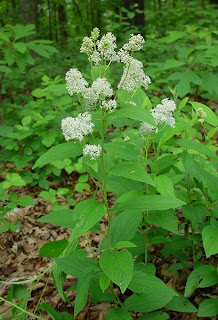RED ROOT

Latin Name: Ceanothus americanus
Alternate Names: Deerbrush, Lilac Bush, Tobacco Brush, Buckbrush, Snowbrush
Family: RHAMNACEAE
Parts Used: Root, root bark, leaves.
Properties: Antispasmodic, Astringent, Expectorant, Hypotensive, Sedative.
Internal Uses: Adenoid Enlargement, Asthma, Bronchitis, Cough, Cysts, Diarrhea, Dysentery, Dysmenorrhea, Epstein-barr Virus, Fatigue, Fever, Headache, Hemorrhoids, Hepatitis, Hodgkin's Disease, Lymphatic Congestion, Mononucleosis, Nosebleeds, Sore Throat, Spleen Enlargement, Testicular Hydrocele, Tick Fever, Tonsillitis, Tumors
Internal Applications: Tea, Tincture, Capsules.
Red Root seems to aid blood coagulation. It is excellent to move catabolic waste buildup and break up tumors and engorgements in the body. It helps ovarian and breast cysts.
Red Root seems to aid blood coagulation. It is excellent to move catabolic waste buildup and break up tumors and engorgements in the body. It helps ovarian and breast cysts.
Topical Uses: Mouth Infection
Topical Applications: Mouthwash and gargle for infections. Flowers can be used to wash the body, as they produce a lather when mixed with water.
Energetics: Bitter, Cool.
Chemical Constituents: Emmolic acid, malic acid, oxalic acid, pyrophosphoric acid, betulinic acid, resin, tannin, methyl salicylate, coagulant.
Contraindications: Mild enough to be used for extended periods of time.
Comments: It is called New Jersey Tea because it was used as a substitute for black tea during the Revolutionary War. The taste is similar to tea, but Red Root contains no caffeine. Native Americans used it as a poultice to treat skin cancers and venereal lesions. The genus name Ceanothus is derived from a Greek type of spiny shrub.
The common name Red Root includes the species Ceanothus thyrsiflorus, Ceanothus spinosa, Ceanothus velutinus, Ceanothus integerrimus, Ceanothus cuneatus and other Ceanothus species, which are used interchangeably with Ceanothus americanus.
The common name Red Root includes the species Ceanothus thyrsiflorus, Ceanothus spinosa, Ceanothus velutinus, Ceanothus integerrimus, Ceanothus cuneatus and other Ceanothus species, which are used interchangeably with Ceanothus americanus.

Comments
A standard infusion (tea) uses about one ounce of fresh plant matter, or 2-5 grams dry, finely chopped, steeped in a covered or closed vessel for at least 10 minutes (really 20 for hard roots, especially if they're dry), up to overnight. Susun Weed recommends infusing in a closed Mason jar for at least 8 hours.
Best wishes toward good health.